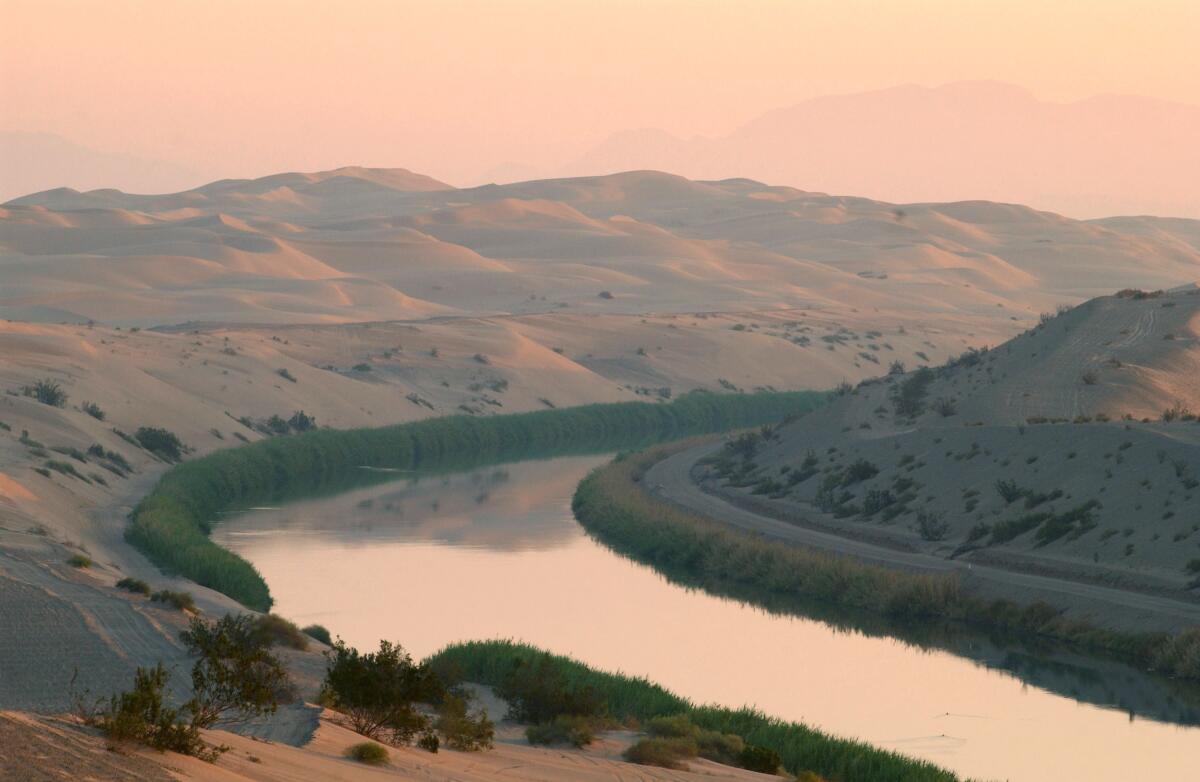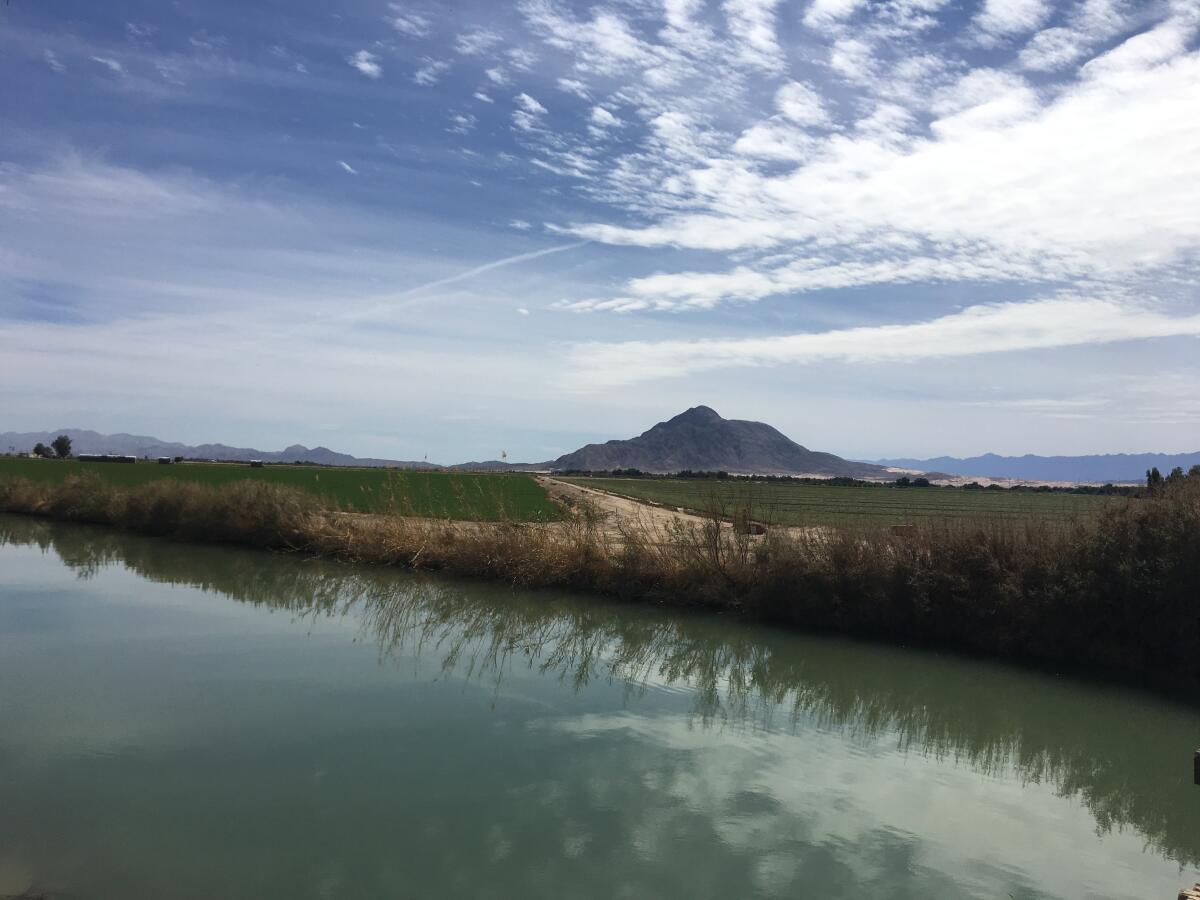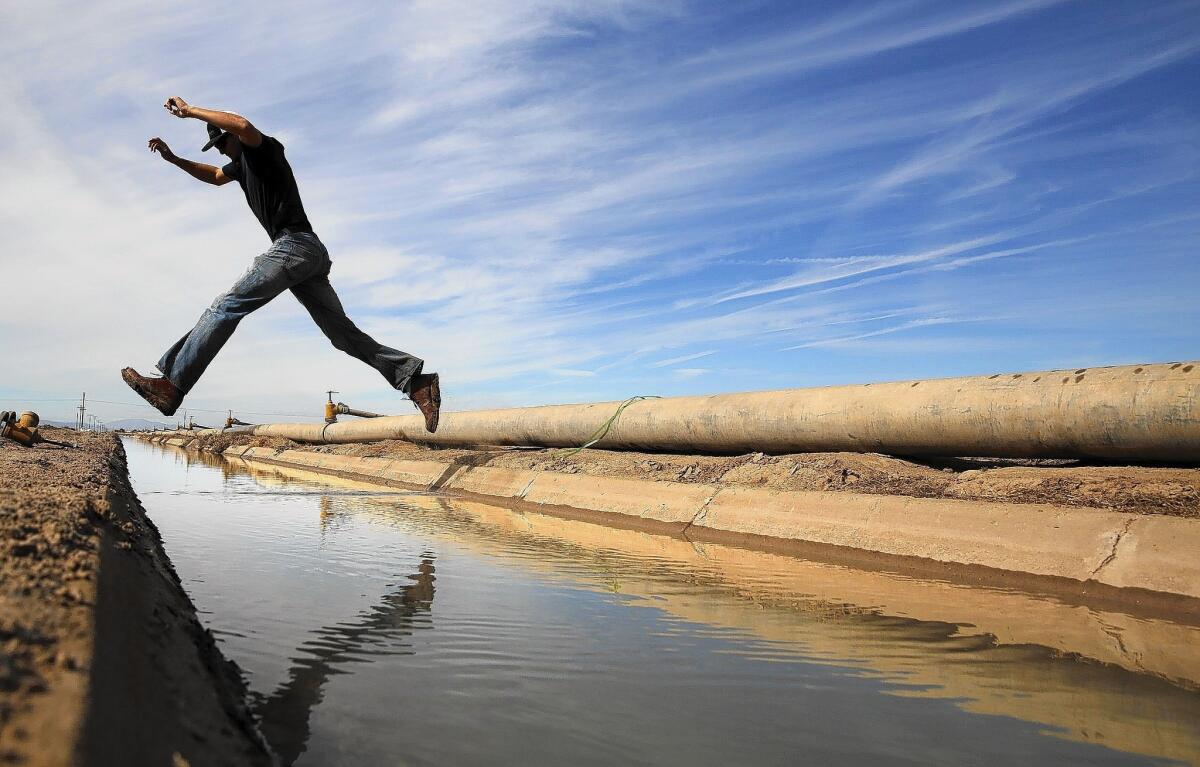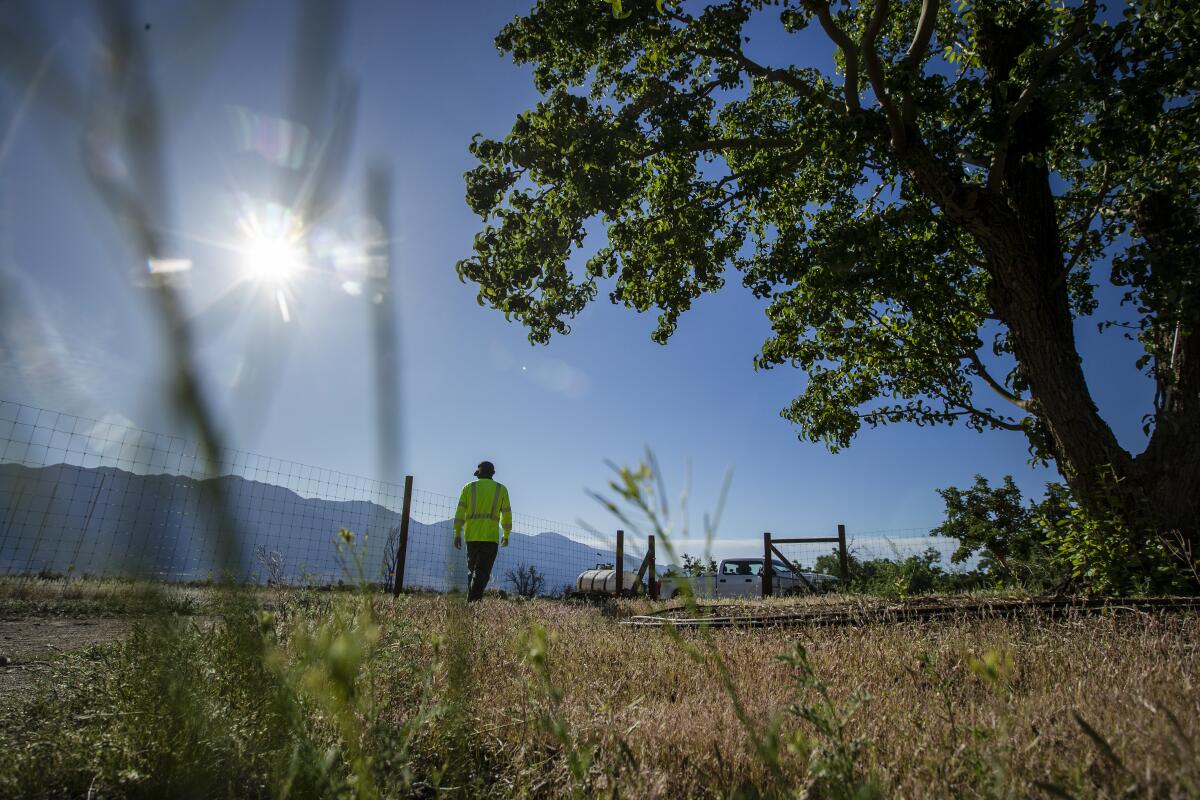A long-simmering water battle comes to a boil in Southern California

If, like me, you live in Los Angeles — or Denver, Las Vegas, Phoenix or Salt Lake City — you drink water from the Colorado River. You probably eat vegetables grown with Colorado River water, and maybe you eat beef fed on alfalfa grown with Colorado River water. When you switch on a light or charge your phone, some of the electricity may be generated by Colorado River water.
The Colorado, in other words, makes life possible in the American West.
Nowhere is that more true than the Imperial Valley, a sun-baked desert in California’s southeastern corner where around 500 landowning families use Colorado River water to grow much of the country’s winter vegetables. I’ve spent lots of time there as a reporter. It’s a tragic and beautiful place. Beautiful in the way the sunlight glints across a lattice of irrigation canals that crisscross endless green farm fields, and tragic in the widespread poverty and pollution that undergird a lucrative agricultural economy.
And more recently, tragic because Imperial County has California’s highest per capita rate of COVID-19 cases.

In terms of water, the valley is especially important because the Imperial Irrigation District holds a right to an astounding 3.1 million acre-feet of the Colorado River’s annual flow. That’s roughly 20% of all the river’s water allocated across seven western states. It’s about two-thirds of California’s stake in the Colorado, and as much as Arizona and Nevada receive combined.
Toward a more sustainable California
Get Boiling Point, our newsletter exploring climate change, energy and the environment, and become part of the conversation — and the solution.
You may occasionally receive promotional content from the Los Angeles Times.
Climate change, meanwhile, is diminishing the river’s flow, which is especially worrying because longstanding legal agreements already promise western states more water from the Colorado than is typically available, as John Fleck and Eric Kuhn detailed in a recent book. There’s a reckoning coming, unless cities and farm districts across the West band together to limit consumption.
The coming dealmaking will almost certainly need to involve the river’s largest water user, the Imperial Irrigation District.
But at the moment, it’s unclear to what extent the district actually controls the Imperial Valley’s Colorado River water.
That was the issue debated in a San Diego courtroom last week, or at least a video conference standing in for a courtroom. A three-judge appellate court panel heard arguments from lawyers for the irrigation district and landowning farmer Mike Abatti, who sued the agency to overturn a water apportionment plan that he says would unjustly limit his use of water for irrigation.
Who is Mike Abatti? As a reporter for the Desert Sun in Palm Springs, I spent many months investigating his enormous influence in the Imperial Valley. I discovered a pattern of government officials with ties to Abatti making decisions that advanced his financial interests — including a public agency that awarded a $35-million energy contract to a company led by Abatti, and a district attorney who publicly cleared Abatti of wrongdoing on the energy contract after describing him as a “good friend.”
I also found that the trial court judge who presided over Abatti’s water lawsuit against the Imperial Irrigation District — and ruled in his favor — had a long history of business and social ties to the Abatti family.
In a sweeping decision, Judge L. Brooks Anderholt found that Imperial Valley farmers hold a “constitutionally protected property right” to the region’s Colorado River water, and that the irrigation district’s elected board members have a limited ability to reduce deliveries to agricultural users. Anderholt’s ruling seemed to tilt the balance of power from the district to landowning farmers.
For the record, Abatti and Anderholt never responded to my requests for comment when I wrote those stories. Imperial County’s district attorney, Gilbert Otero, defended the integrity of his investigation and rejected the idea he had a conflict of interest.
All of which brings us back to last week’s appellate court hearing.
Lawyers for both sides focused their arguments on the central question of who controls the water.
Abatti’s attorney, Cheryl Orr, said farmers have a right to however much water they “reasonably need” to cultivate their crops, based on past use. (Farmers currently use 97% of the Imperial Valley’s water.) Orr told the judges that under established law, farmers “have a priority of water that is different and higher than just an ordinary use,” such as household drinking water.
The irrigation district board “just unilaterally determined that they were going to reorder the priorities and put agriculture at the bottom of the list,” Orr said. “They’re treating farmers as customers of the water district. And they’re not customers.”

Irrigation district attorney Jennifer Meeker countered that the agency’s elected board members have wide latitude in how they apportion water, so long as they don’t cut off deliveries to farmers. A constitutionally protected property right, she said, would give farmers “a first grab at the water to fulfill all of their past use, and then whatever’s left can go to anybody else.”
“If you get to a point where there is such a shortage that there just simply is not enough water, everybody is going to end up being curtailed,” Meeker told the judges. The irrigation district’s elected board, she said, “has the right and the discretion” to develop a plan for spreading water cutbacks fairly among farmers, cities and industrial users such as geothermal power plants.
Whichever side wins, the outcome is liable to radiate outward across the West, like a stone creating ripples in a reservoir.
More control for the landowning farmers could make future Colorado River negotiations more difficult — or make it harder for growing cities to acquire water supplies that rightfully belong to the Imperial Valley, depending on how you look at it.
It’s not just Abatti’s lawsuit that could affect Imperial’s role in high-stakes Colorado River negotiations. Local politics are an important factor, too. In April, I wrote about a contentious election for a seat on the irrigation district board. The campaign has fueled rampant speculation over which candidates might secretly be backed by which local power brokers — including Abatti.
It didn’t have to be this way. The scientist and explorer John Wesley Powell — famous for mapping the West and leading a Colorado River expedition through the Grand Canyon in 1869 — warned that most lands west of the 100th meridian didn’t have enough rainfall to support farming. To the consternation of economic boosters who proclaimed, “Go West, young man,” Powell advised a careful regional approach to irrigation and development, organized by watershed rather than arbitrary state lines.
Powell’s advice was largely ignored, of course. The proponents of Manifest Destiny were too strong, the profits too tantalizing.
So here we are, 150 years later, awaiting results from the courtroom and the ballot box. I’ll update you when the time comes.
And for now? Next time you pour a glass of water or eat a hamburger, think about the Colorado River.
Here’s what else is happening around the West:
TOP STORIES
Pacific Gas & Electric is finally exiting bankruptcy. But is the company any better positioned to prevent wildfires and stop killing its customers? I took an in-depth look at the utility’s reorganization plan, and found the new PG&E looks a lot like the old PG&E. (Also this week, PG&E pleaded guilty to 84 counts of involuntary manslaughter, with CEO Bill Johnson saying, “Guilty, your honor” 84 times while a judge read the names of nearly every person who died in the Camp fire, as my colleague Julia Wick reports.)
The gas utility industry is paying Instagram influencers to post about how much they love #cookingwithgas. Yes, this is exactly what it sounds like; go read Rebecca Leber’s story for Mother Jones to learn more about the sponsored posts that are circulating on social media. They’re part of a larger campaign by the gas industry to fend off efforts to replace natural gas, a planet-warming fossil fuel, with cleaner electricity for heating and cooking. I wrote more about the industry pushback last year.
The COVID-19 pandemic is unleashing a tidal wave of plastic waste. You can probably guess where this is going: Huge numbers of disposable masks are turning up on beaches, as the coronavirus drives increased use of gloves, takeout containers, delivery packaging and other plastic materials. Here’s the story from The Times’ Shashank Bengali. Meanwhile, new research finds plastic particles are raining down on national parks from Joshua Tree to Rocky Mountain, as the Denver Post’s Bruce Finley reports.
ENVIRONMENTAL INJUSTICE
A metal recycling facility next to a Los Angeles high school is getting sued. School district officials say the facility has released sharp pieces of metal, smoke, fumes and more onto school grounds, endangering students in Watts, a predominantly Black and Latino neighborhood, as Tony Barboza reports for The Times. Critics say this is an example of environmental injustice — a term that describes how pollution disproportionately affects people of color and poor communities, as I discussed a few weeks ago.
Environmental injustice is alive and well on the Navajo Nation, the country’s largest reservation. Under a bill passed by the Senate, hundreds of Navajo households in Utah would finally get running water, per the Salt Lake Tribune’s Zak Podmore. But the fact that many indigenous people don’t already have easy access to clean water is mind-boggling. Some Navajos blame the problem in part on a coal mine that for decades sucked water from an underground aquifer, as Bloomberg’s Tripp Baltz reports.
The California Air Resources Board is scheduled to vote next week on a regulation that would require truck manufacturers to sell more zero-emission vehicles. The regulation is designed to reduce hazardous pollution from diesel trucks, which is often breathed by people of color and poor communities in “diesel death zones” along freeways, as Julia Kane reports for InsideClimate News. The freight and oil industries are urging regulators to hold off, citing the economic fallout from the COVID-19 pandemic.
Enjoying this newsletter? Consider subscribing to The Times
Your support helps us deliver the news that matters most, and makes newsletters like Boiling Point possible. Become a Los Angeles Times subscriber.
POWER STRUGGLES
A state court told San Diego County it can’t let housing developers avoid reducing climate pollution from new car traffic by using “carbon offsets” that might reduce emissions in other states, or even other countries. Here’s the story from Joshua Emerson Smith at the San Diego Union-Tribune. This is the sixth time a court has rejected the county’s climate action plan.
Speaking of San Diego, Warren Buffett is interested in buying the city’s power grid. That’s according to this story by the Union-Tribune’s Rob Nikolewski, focused on a dispute between city officials and San Diego Gas & Electric, an investor-owned utility company owned by Sempra Energy. SDG&E’s 50-year license to operate in the city is slated to expire next year, and Buffett’s Berkshire Hathaway conglomerate is one of the companies that has said it might want to take over local electric operations.
AROUND THE WEST
Drought conditions are expanding from California to Colorado, my colleague Paul Duginski reports. In some ways this is no surprise; as John Wesley Powell tried to warn us a century and a half ago, water scarcity is more the norm than the exception in the West. But now climate change is making things worse; Paul notes that last month was the region’s fifth-warmest May on record.
Let’s return to the Navajo Nation for a minute. Tribal members are fighting against a Trump administration oil and gas leasing plan that could bring fracking to the doorstep of Chaco Canyon in New Mexico, home to historical artifacts sacred to Navajo and Puebloan people, per the Guardian’s Cody Nelson. As one activist put it: “The fight has constantly been, ‘These are sacred sites.’ But the non-indigenous power is like, ‘Well prove to us these are sacred sites.’ How can we prove that when it’s our beliefs?”

This last one isn’t exactly an environmental story. But Louis Sahagun wrote a beautiful piece for The Times about National Park Service employees who tend to an orchard at Manzanar, the site of a former Japanese American internment camp in California’s Owens Valley. The grove of fruit trees, which was first planted in the 1920s, serves as a living touchstone for surviving prisoners.
What do you want to know?
When you think about California’s climate future, what comes to mind? What keeps you up at night, and what gives you hope or gets you excited? What do you want to understand, and what should I?
This newsletter is for you, to help you understand how we’re changing our world and what we can do about it, and I want to hear your questions, concerns and ideas. Email me or find me on Twitter.
ONE MORE THING
Last month, I reported that San Luis Obispo’s city council delayed voting on an ambitious climate policy after a Southern California Gas Co. union leader threatened to bus in hundreds of protesters, which he said would “potentially [add] to this pandemic.”
The drama has now ended: City council approved the policy without incident this week in a 4-0 vote, paving the way for a shift to all-electric buildings in this city along California’s Central Coast. Nick Wilson covered the vote for the San Luis Obispo Tribune.
But while protesters didn’t storm the meeting, competing arguments did storm my inbox in the hours leading up to the vote.
The California Black Chamber of Commerce submitted a letter opposing the policy, although the chamber’s president later told Wilson that he never saw the final version, which was sent by a lobbyist, and that the tone was “incendiary and divisive.” The local NAACP chapter was also forced to clarify that it supports the building electrification policy, after a public relations firm with gas industry ties claimed in an email that San Luis Obispo’s mayor “is getting a lot of heat” from groups including the local NAACP.
As Amy Harder recently reported for Axios, the gas industry has won support from some leading civil rights activists, who say moving away from fossil fuels too quickly could raise energy costs. The national NAACP, though, has warned local chapters against accepting fossil fuel money and then lobbying on the industry’s behalf, as Ivan Penn reported for the New York Times in January.
I’ll be back in your inbox next week. If you enjoyed this newsletter, please consider forwarding it to your friends and colleagues.




